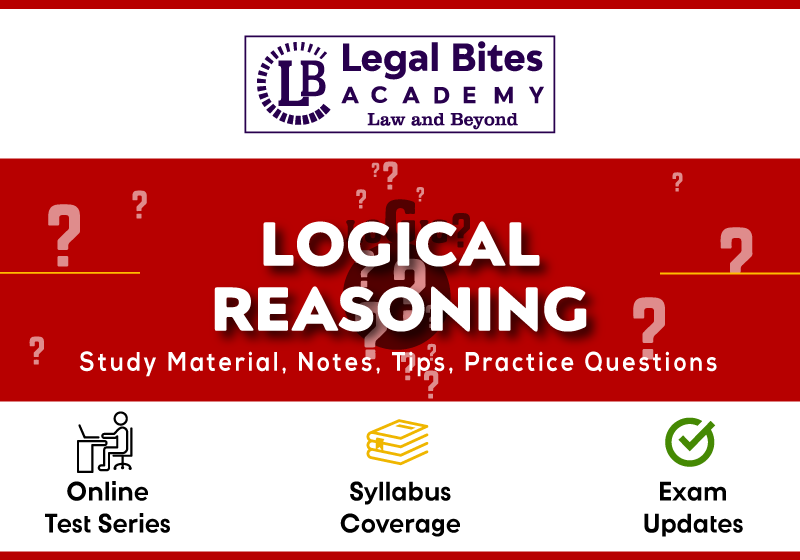CLAT UG Logical Reasoning Exam Format and Preparation Strategies
The CLAT UG Logical Reasoning section has a weightage of nearly 20% of CLAT Paper. It is important for the candidate to get familiarised with the kind of questions, the language of the questions, and the methods of approaching a particular question. Forms of Questions The questions in this section will be based on: How do patterns of… Read More »

The CLAT UG Logical Reasoning section has a weightage of nearly 20% of CLAT Paper. It is important for the candidate to get familiarised with the kind of questions, the language of the questions, and the methods of approaching a particular question. Forms of Questions The questions in this section will be based on: How do patterns of reasoning in the passage compare to various options provided? Which are they most similar to, or different from? Which of the provide options most...
The CLAT UG Logical Reasoning section has a weightage of nearly 20% of CLAT Paper. It is important for the candidate to get familiarised with the kind of questions, the language of the questions, and the methods of approaching a particular question.
Forms of Questions
The questions in this section will be based on:
- How do patterns of reasoning in the passage compare to various options provided? Which are they most similar to, or different from?
- Which of the provide options most closely resembles, contradicts, supports, or contradicts the arguments set out in the passage?
- What role does a statement or piece of information in the passage play in relation to an argument? Does it support or weaken the argument? Does it support or weaken the argument, does it clarify the argument, does it clarify the argument, does it demonstrate an inconsistency between the premise and the argument?
- What is the main point of the passage? What is its conclusion?
- Which of the provided options is an assumption on which the argument?
- Depends? Which is a premise?
- What possibility or piece of information does the argument in the passage fail to take into account?
Exam Format
This section will give you a better understanding of how to approach questions in the Logical Reasoning section of the UG CLAT 2021. The Logical Reasoning section of the UG-CLAT 2021 will include a series of short passages of about 300 words each. Each passage will be followed by one or more questions that will require you to:
- Recognize an argument, its premises and conclusions;
- Read and identify the arguments set out in the passage;
- Critically analyse patterns of reasoning, and assess how conclusions may depend on particular premises or evidence;
- Infer what follows from the passage and apply these inferences to new situations;
- Draw relationships and analogies, identify contradictions and equivalence and assess the effectiveness of arguments.
Preparation Strategies
- While the Logical Reasoning section of the UG CLAT 2021 is very different from previous years’ papers, some questions from the older formats may still be included – such as logic games or syllogisms. It would, therefore, be a good idea to practice with previous years’ papers, so that you can pick up some ‘easy’ marks for such questions.
- This section of the UG CLAT 2021 is closely related to the English Language and Legal Reasoning sections. Given this, it would be a good idea to modify your preparation strategy so that you prepare for these three sections together. Very often, the same, or similar sources are used by the question setters for questions in this section as in the English Language and Legal Reasoning sections – such as opinion and editorial pieces from newspapers. Since this is the case, every time you read a newspaper story while preparing for the English Language, Legal Reasoning, or even Current Affairs and General Knowledge, try and go through the steps identified previously – what is the main point of the passage? What is the author’s stance on a particular issue? What premises does the author offer in support of the conclusion? How would the conclusion differ if the premises were changed? And so on… As with the Current Affairs and General Knowledge section of the UG CLAT 2021, this is another section where discussions with a small group of people may help – try and create different versions of a principle or facts, and ask others to determine how they may affect the main argument or outcome of a passage or a question – the more you debate points with others, the greater the variety of arguments and reasoning styles you will encounter, which will help you tremendously with your preparations.
- The sample questions and Model Papers released by our platform are, of course, your best source for practice – but there are a number of different sources where you may come across similar questions. In particular, try and see if you want to practice with the free question sets offered on the website of the CLAT consortium, LSAT or the LNAT – while these may not correspond exactly with the pattern of the UG CLAT 2021, they will help you develop the same skills of comprehension, analysis, deduction, and application that the Logical Reasoning section of the UG CLAT 2021 seeks to evaluate.
Source: Official Website – Consortium of National Law Universities, Available Here
Admin Legal Bites
Legal Bites Study Materials correspond to what is taught in law schools and what is tested in competitive exams. It pledges to offer a competitive advantage, prepare for tests, and save a lot of money.

